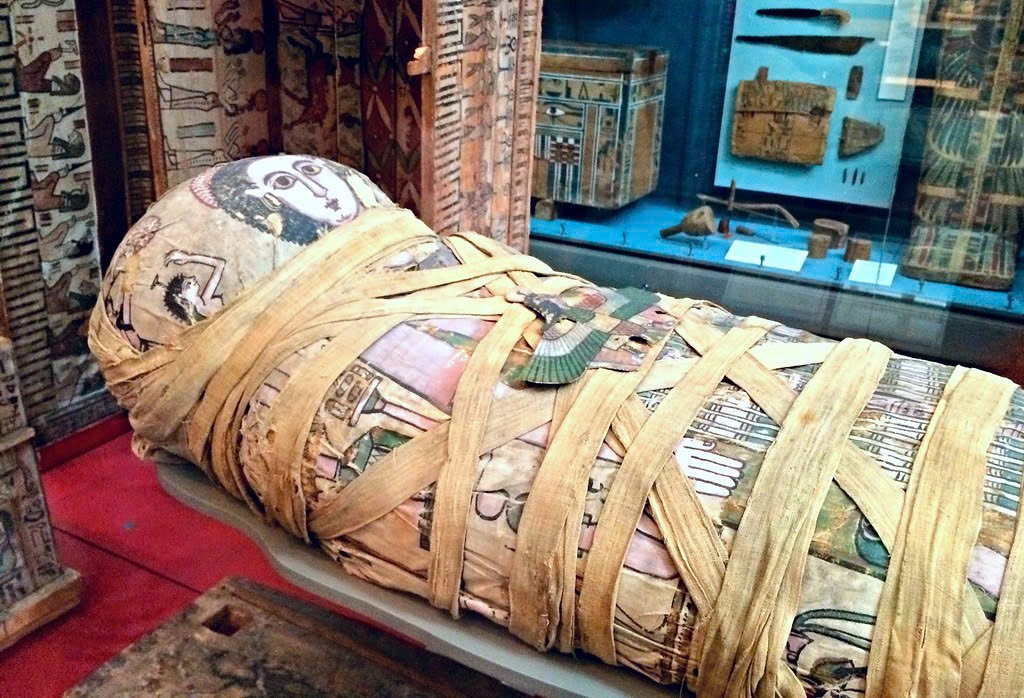In the hallowed halls of the British Museum rests a compelling relic from the ancient world—the mummified remains of a young Egyptian woman named Cleopatra. Unlike the famously powerful Cleopatra VII, whose legacy has echoed through centuries of history and legend, this Cleopatra was a 17-year-old girl who lived during the Roman Period of Egypt, specifically between 100 and 120 CE. Despite her relatively short life, her remains offer profound insights into the rich cultural, religious, and medical practices of her time, revealing a deeply interconnected world where Greek, Roman, and Egyptian influences converged.

This young Cleopatra was not an ordinary citizen of ancient Egypt. Her lineage placed her among the elite. Inscriptions found near her burial site indicate she was the daughter of Candace, a member of the prestigious Cornelius Pollius family—a Roman family of significant standing. Her father held the position of Archon of Thebes under the reign of Emperor Trajan, one of Rome’s most esteemed rulers. This role was a high civic office, denoting both political influence and substantial wealth. Cleopatra’s social standing ensured she would receive not only the best in life but also the most elaborate preparations in death—a burial that would preserve her legacy and assist her journey into the afterlife.
Tragically, Cleopatra’s life ended at the age of 17 years, 1 month, and 25 days. While the cause of her early death remains unknown, such premature deaths were not rare in antiquity, where disease, complications from childbirth, and other health challenges claimed many young lives. What is especially poignant about Cleopatra’s story is not only her untimely passing but also the care and reverence with which her body was preserved—testament to the enduring love of her family and their desire to honor her status in both life and death.
Even though she bore a Greek name and lived during a time when Egypt was under Roman rule, Cleopatra’s mummification adheres to distinctly Egyptian religious customs. Her body was meticulously wrapped in linen, and her funerary adornments include depictions of prominent Egyptian deities such as Isis, Nepthys, Anubis, and Nut. These figures were central to ancient Egyptian beliefs about death and the afterlife. Their presence on her burial wrappings indicates the cultural and spiritual importance placed on the journey after death, even in an era where Roman and Greek customs had begun to merge with traditional Egyptian practices. This blend of Greek identity, Roman political influence, and Egyptian religious rites highlights the complex tapestry of cultures that defined Roman-period Egypt.
Cleopatra’s burial site, located in Sheikh Abd el-Qurna in Thebes—a necropolis rich with the tombs of nobles and elite individuals—contained several items intended to accompany her into the afterlife. These included a string of berries, possibly used as a necklace or symbolic offering, a garland or wreath, perhaps placed on her body or in her tomb as a sign of honor, and a wooden comb, suggesting attention to personal grooming and care. These objects, while simple, hold deep cultural meaning. They reflect the ancient Egyptian belief that the afterlife was a continuation of earthly life, requiring the same comforts and symbols of identity and status.
Thanks to modern medical imaging technology, Cleopatra’s mummy, cataloged as EA6707, has been studied extensively using X-ray analysis. These examinations have uncovered numerous intriguing details that help modern researchers understand both her physical condition and the mummification process used in her preservation. The scans reveal that much of her body is obscured by dense material, likely plaster, which was commonly used in Roman-era Egyptian mummification to mold and support the body.
Interestingly, the scans show no evidence of fractures in her ribs, arms, or legs, indicating she likely did not suffer significant physical trauma before death. A mass of unknown material is present within her body cavity, a detail that raises questions for researchers about its origin—whether it’s related to internal preservation methods or post-mortem changes. Her arms are extended along her sides, with the palms resting on her thighs, a typical position seen in mummies from this period. Additionally, a dislocated left hip is visible, likely caused by the tight wrapping process rather than injury or disease. Importantly, no signs of arrested growth were observed, suggesting that Cleopatra developed normally for her age.
Cleopatra’s preserved body continues to captivate both scholars and museum visitors. Her mummy is more than a relic; it is a symbol of the cultural crossroads at which she lived. The blending of Greek name, Roman political family, and Egyptian burial rituals paints a vivid picture of Roman Egypt—a time when diverse traditions coexisted and influenced one another. Her story also reflects the universal human experience of loss, remembrance, and the hope for life beyond death.
By studying Cleopatra’s mummy, historians and archaeologists gain more than just knowledge about a single individual—they gain access to a broader understanding of how ancient societies approached life, death, and the spiritual journey. This young girl’s remains have become a powerful link to the past, illuminating the beliefs, values, and daily realities of people who lived nearly two thousand years ago.
In preserving and sharing Cleopatra’s story, the British Museum not only honors her memory but also enriches our collective understanding of history. Her life, though short, was significant in its reflection of ancient Egypt’s enduring traditions amid a changing world. Her death, carefully commemorated with symbols of love and respect, continues to inspire awe and wonder, reminding us of the timeless human desire to seek meaning, preserve memory, and honor those we have lost.





